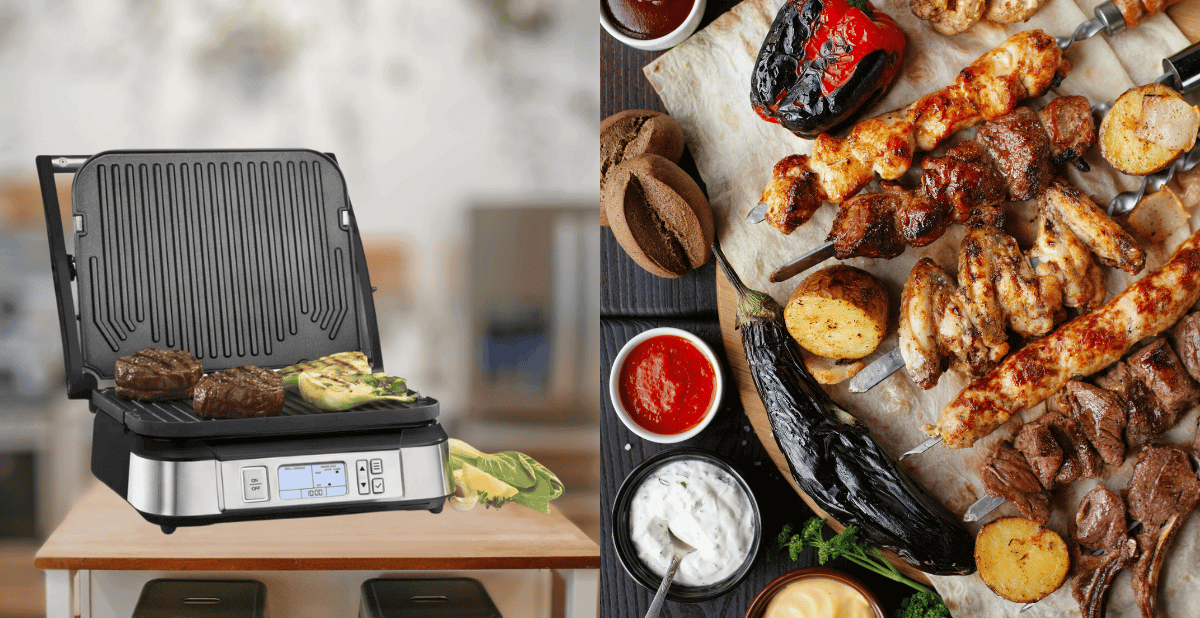Grilling is a beloved cooking method that offers a distinct smoky flavor that's hard to copy. However, traditional grilling comes with a side of smoke that isn't always welcome. Where does the smoke go in smokeless grills?
Let's examine the mechanics of smokeless grills and discover how they keep the air clear while delivering a delicious grilled meal. I love the way everything tastes better when grilled! 💖
Key Takeaways:
- Smokeless grills utilize advanced technology to reduce smoke production during cooking.
- Key components like grill plates, drip pans, and water trays work together to minimize and capture smoke.
- Understanding how smokeless grills function can help users maintain them effectively for optimal performance.
The Science Behind Smokeless Grilling
Smokeless grills have revolutionized indoor cooking by allowing grill lovers to cook their favorite dishes without setting off the smoke alarm.
But how exactly does a smokeless grill work?
At its core, the technology focuses on controlling and reducing the smoke produced during grilling.
This is achieved through a combination of heat management and smoke capture mechanisms.
The Role of Grill Plates
Grill plates in smokeless grills are designed to prevent fat and juices from dripping directly onto the heating element.
This is crucial because the contact between these drippings and the high heat typically creates smoke.
By using grill plates that channel these liquids away from the heat source, smokeless grills significantly reduce the amount of smoke produced.
Heating Elements and Smoke Reduction
The heating element in a smokeless grill is another vital component in reducing smoke output.
Unlike charcoal grills or gas grills, an indoor electric grill uses a heating element that provides consistent heat without the flare-ups that cause excessive smoke.
This controlled heating ensures that the cooking surface remains at an optimal temperature to cook food without burning it, which is another common source of smoke.
Drip Pans and Water Trays
A removable drip tray or water tray underneath the grill plates is common in smokeless grills.
These trays collect the fat and juices that run off the grill plates, preventing them from burning and creating harmful smoke.
Some models even suggest adding water to the tray, which helps to cool the drippings quickly and further reduce smoke production.
Smokeless Doesn't Mean Flavorless
One might wonder if the lack of smoke compromises the smoky flavor that is the hallmark of a great grilled meal.
Smokeless grills impart a smoky taste using wood chips or other flavor enhancers that do not produce smoke.
This allows for a smoky flavor without the harmful smoke from traditional outdoor cooking methods.
The Importance of Ventilation
Even though smokeless grills are designed to minimize smoke, proper ventilation is still important.
Indoor grills should be used in well-ventilated areas to ensure that any residual smoke is quickly dissipated.
This helps maintain a smoke-free environment and ensures that the indoor air quality remains healthy.
Innovative Smoke Extraction Systems
Smokeless grills are revolutionizing the way we cook indoors, but have you ever wondered how a smokeless grill works to keep the air clear?
These grills have innovative smoke extraction systems that actively remove smoke from your cooking surface.
Picture a tiny yet powerful vacuum built right into your grill plate.
As soon as smoke begins to waft off your sizzling steak, it's whisked away before it can escape into your kitchen.
This technology is a game-changer for apartment dwellers and those without access to outdoor grills, allowing for a grilling experience without the smoky aftermath.
The effectiveness of these systems can vary between models, but the principle remains the same.
Some indoor grill models use a combination of fans and filters to purify the air.
These filters can often be removed and cleaned, ensuring that your smokeless grill remains efficient.
It's not just about comfort; it's also about safety.
These grills minimize the risk of setting off smoke alarms or irritating sensitive lungs by reducing the amount of smoke produced.
So, you can grill your favorite foods with peace of mind, knowing that the air around you stays as fresh as your ingredients.
The Efficiency of Gas Grills in Smokeless Technology
Gas grills are often lauded for their efficiency and ease of use, and when it comes to smokeless technology, they're no slouch either.
A smokeless grill works by minimizing the smoke produced during the cooking process.
This is particularly important when using a gas grill indoors or in confined spaces with limited ventilation.
The design of these grills typically includes a tightly controlled flame that heats the grill plates directly, reducing the chance of fat and juices from the food igniting and causing smoke.
Moreover, gas grills with smokeless features often come equipped with advanced temperature controls.
This allows for precise cooking, ensuring perfectly grilled food every time and crucially reducing smoke.
By maintaining the right temperature, these grills prevent overheating and avoid the burning of food, which is a common source of unwanted smoke.
This precision and smokeless technology make gas grills popular for barbecue enthusiasts who prefer a cleaner grilling experience.
Drip Pan Innovations in Smokeless Grilling
The humble drip pan is an unsung hero in smokeless grilling.
It's not just about catching the fat and juices that run off your deliciously grilled steak; it's about how a smokeless grill works to keep those drippings from turning into smoke.
Modern smokeless grills have drip pans designed to cool the drippings quickly, often using water or other cooling agents.
This rapid cooling prevents the drippings from burning and creating smoke, essential for an indoor grilling experience.
In addition to cooling, some drip pans are coated with non-stick materials or are specially textured to ensure that grease and juices are efficiently transported away from the heat source.
This design consideration keeps the grill cleaner and reduces the need for frequent maintenance.
It also contributes to the overall smokeless operation, as less residue in the pan means less chance of smoke.
These innovations in drip pan design are key to the success of smokeless grills, making them a favorite for those who want the grilled flavor without the smoky aftermath.
The Evolution of Grill Plates
Grill plates are at the heart of what makes a smokeless grill work effectively.
The latest designs in grill plates are not only about reducing smoke but also about enhancing the cooking experience.
Manufacturers are constantly innovating, creating grill plates with non-stick surfaces that make cooking and cleanup a breeze.
But it's not just about convenience; these surfaces help to produce smoke by ensuring that juices and fats don't stick and burn, which is a common cause of smoke on traditional grills.
Moreover, the evolution of grill plates has led to the creation of dual-purpose plates, where one side serves as a traditional grill and the other as a griddle plate.
This versatility means you can sear a steak perfectly on one side, then flip the plate to cook pancakes on a smooth surface.
It's like having an outdoor grill and a diner-style griddle all-in-one appliance.
This innovation saves space in your kitchen and expands your culinary repertoire.
Whether flipping burgers or crafting the perfect crepe, the modern grill plate is your companion for smokeless, versatile cooking.
Keeping Your Grill Cool
Another aspect of smokeless grilling is managing the temperature of the grill itself.
Smokeless grills are often designed with cool-touch exteriors to prevent the grill's exterior from getting too hot, which also contributes to a safer cooking environment.
This feature is vital for indoor grills, where the risk of accidental burns can increase due to the confined cooking space.
The Convenience of a Contact Grill
Many smokeless grills are also contact grills, meaning they have a lid that cooks food from the top and the bottom.
This speeds up the cooking process and helps to contain any smoke that might be produced, as the lid acts as a barrier between the food and the open air.
Dishwasher Safe Components
Ease of cleaning is another benefit of smokeless grills.
Components like the grill plates, dripping tray, and water tray, are often dishwasher safe, making the post-cooking cleanup a breeze.
This convenience encourages regular cleaning, which is essential for maintaining the smokelessness of the grill.
The Versatility of Griddle Plates
Some smokeless grills come with interchangeable griddle plates, allowing for various cooking options beyond just grilling.
Griddle plates provide a flat cooking surface ideal for foods that might not be suited for traditional grill plates, such as pancakes or eggs, without producing smoke.
The Dangers of Carbon Monoxide
It's important to note that while smokeless grills reduce visible smoke, they can still produce carbon monoxide, a colorless and odorless gas that can be dangerous in enclosed spaces.
Always ensure your indoor cooking area has a carbon monoxide detector for safety.
Grilling Beyond Meat
Smokeless grills aren't just for cooking flank steak or burgers.
Their consistent heat and smokeless operation make them perfect for grilling vegetables, fruits, and pizzas.
The versatility of these grills opens up a world of culinary possibilities for indoor cooking.
The Future of Smokeless Grilling
As technology advances, smokeless grills will become even more efficient at reducing and eliminating smoke.
Discoveries in heating technology and smoke capture methods will likely lead to even cleaner and more convenient indoor grilling experiences.
Until Next Time...
Smokeless grills offer a way to enjoy grilled foods without the smoke that typically accompanies grilling.
They achieve this through smart design choices, such as specialized grill plates, drip pans, and water trays that capture and cool drippings before they can create smoke.
While they are a great option for indoor cooking, it's still important to use them in well-ventilated areas and to be aware of the potential for carbon monoxide production.
With proper use and maintenance, smokeless grills can provide a delicious and smoke-free grilling experience.
Hope you found our blog helpful.
Thanks for visiting,
MommaPuff













